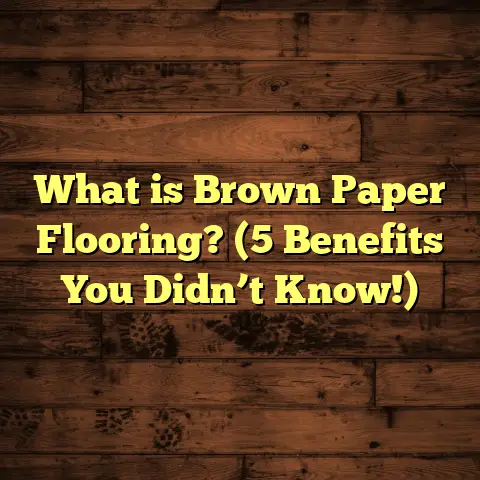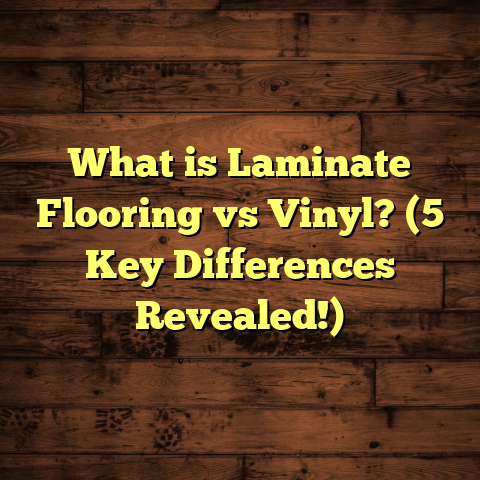What is Solid Core Engineered Flooring? (5 Key Benefits & Uses)
I still recall the moment a client called me about a new flooring option they’d heard of—solid core engineered flooring. They were especially concerned about indoor air quality because their kids had asthma. I told them this type of flooring could be a real game-changer for health and comfort. After installing it, they told me the air felt cleaner, and the floors were sturdy and beautiful. That experience made me realize just how important flooring choices are—not just for looks but for our well-being.
So if you’ve been wondering about solid core engineered flooring and why it’s gaining traction among homeowners and pros alike, let’s have a chat. I’ll share what I’ve learned from years on the job, including practical tips on installation, maintenance, and real-world performance.
How Flooring Affects Indoor Air Quality (And Why You Should Care)
Before we get into the nuts and bolts of solid core engineered flooring, I want to highlight something I don’t hear enough about—how much our floors influence the air we breathe at home.
You might not think of your floors as a factor in indoor air quality (IAQ), but they absolutely are.
Hard surfaces like tile or hardwood don’t trap dust as much as carpets, but poorly made or installed floors can still harbor allergens in gaps or off-gas chemicals from finishes and adhesives.
I’ve worked in homes where mold developed beneath floors due to moisture intrusion. That can seriously impact respiratory health.
Solid core engineered flooring, with its dense core and tight tongue-and-groove system, minimizes gaps where dust collects. Plus, manufacturers often use low-VOC (volatile organic compounds) adhesives and finishes, which greatly reduce chemical emissions.
Here’s a fact: The EPA says indoor air pollution can be 2-5 times higher than outdoors. That’s alarming! Choosing healthier flooring materials is one simple way to lower indoor pollutants.
When I explain this to clients, they usually say, “I never thought about how the floor could affect breathing.” It’s an overlooked detail that’s easy to improve with the right flooring choice.
What Sets Solid Core Engineered Flooring Apart?
Most people know about traditional engineered hardwood floors made with plywood cores. These work fine most of the time but tend to react poorly to moisture changes. That leads to warping, gaps, and sometimes even mold growth underneath.
Solid core engineered flooring uses a different approach—a single dense core material like high-density fiberboard (HDF) or hardwood strips glued together tightly.
This design makes the floor far more dimensionally stable. It won’t swell or shrink as much under humidity swings.
I’ve tested this firsthand in coastal homes where humidity is high year-round. Solid core floors held up beautifully while plywood-core floors swelled and cupped within months.
This stability also means fewer squeaks and creaks—a welcome benefit if you’ve ever lived on aging floors that groan when you walk.
Another big plus is the wear layer—the top hardwood veneer. On solid core engineered flooring, this layer is often thicker than on traditional engineered floors, sometimes 3-6 mm or more. That means you can sand and refinish these floors multiple times over their lifespan.
I’ve refinished solid core floors four or five times in some homes that are 15 years old and still going strong.
Story from the Field: A Coastal Home Success Story
I installed solid core engineered flooring in a beach house last year. The homeowner had tried traditional engineered floors before but faced constant warping due to salty sea air and high moisture levels.
We chose a solid core product with a waterproof underlayment and a durable oak veneer.
After 18 months of seasonal humidity swings, the floors look flawless—no gaps, no warping, no discoloration.
The homeowner told me it felt “like walking on solid wood,” which was a big compliment since many engineered products feel hollow or plasticky.
This project reaffirmed for me that solid core engineered flooring is an excellent choice for challenging climates where moisture control is tricky.
Installation Tips Based on Years of Experience
Whether you’re a DIY enthusiast or hiring a pro, installation plays a huge role in how your floor performs long-term.
Here are some practical insights I’ve picked up:
Acclimation Is Critical
You’ll often hear installers say “acclimate your flooring.” This means letting the boards sit in the installation room for 48-72 hours before starting work.
Why? Because wood expands or contracts with humidity. Allowing it to adapt avoids surprises after installation, like gaps forming or boards buckling.
For solid core engineered flooring, acclimation is just as important because despite its stability, it still reacts slightly to moisture levels.
Subfloor Preparation Can’t Be Skipped
A clean, level subfloor is non-negotiable.
I spent one frustrating afternoon fixing a floor where the installer didn’t level the plywood subfloor properly. The solid core floor ended up uneven, causing squeaks and loose boards.
If you’re installing over concrete slabs (common in basements), use a moisture barrier to prevent vapor transmission that could damage your floor over time.
Floating vs Glue-Down Installation
Solid core engineered floors give you flexibility: you can float them over an underlayment or glue them down directly.
Floating installations are faster and easier for DIY projects. They allow slight movement because boards aren’t glued to the subfloor.
Glue-down installations feel more solid underfoot but require more prep work and skill.
I’ve done both methods. For busy families with kids and pets, floating is often my recommendation due to speed and ease of future repairs.
Expansion Gaps Matter
No matter how stable your flooring, always leave expansion gaps (usually 10-15 mm) around perimeter walls. This space lets boards expand naturally without buckling against walls or door frames.
I once skipped this step on a small condo project. The floor buckled badly within months during summer heat—lesson learned!
Maintenance Made Simple (And What To Avoid)
I love when clients tell me their floors still look like new after years of wear. That usually means they’ve followed some easy maintenance habits I recommend:
- Regular Dry Cleaning: Sweep or vacuum frequently using attachments designed for hardwood floors. That prevents dirt grit from scratching the surface.
- Damp Mopping Only: Use a slightly damp mop with pH-neutral wood floor cleaner. Excess water can seep between boards and damage finishes.
- Avoid Harsh Chemicals: No ammonia-based cleaners or vinegar—it wears down finishes prematurely.
- Furniture Protection: Felt pads under chairs/tables prevent dents.
- Sunlight Control: UV rays fade finishes over time; curtains or blinds help protect your investment.
Here’s a tip I pass along: keep pet nails trimmed to avoid scratches—especially on lighter-colored veneers where scuffs show easily.
Five Reasons I Keep Recommending Solid Core Engineered Flooring
1) Stability That Stands Up to Moisture Changes
If you live somewhere with shifting seasons or high humidity, you know how wood floors can swell or shrink unpredictably. Solid core engineered flooring nearly eliminates this problem.
Its dense core resists moisture better than plywood cores, which soak up water and warp quickly.
2) Sound Absorption That Makes Your Home Quieter
Dense cores don’t just resist moisture—they absorb sound better too. In multi-story homes or condos, solid core floors reduce footstep noise significantly compared to hollow laminates or traditional engineered wood.
I noticed this instantly when installing floors in a townhouse complex—neighbors thanked me for making their home quieter!
3) Durability That Lasts Decades
Thanks to thicker wear layers (3-6 mm), these floors can be sanded and refinished multiple times—a luxury rarely found in laminate flooring.
This longevity means fewer replacements, saving money in the long run.
4) Healthier Indoor Air Quality
Low-VOC adhesives and finishes minimize chemical fumes inside your home—a big plus if anyone has allergies or asthma.
Plus, tight joints mean less dust accumulation underboards—a hidden benefit I didn’t expect when first recommending these floors.
5) Versatility for Different Rooms
Unlike solid hardwood that struggles with moisture-prone areas like basements or kitchens, solid core engineered flooring can be installed almost anywhere with proper underlayment.
I’ve installed it in kitchens, bedrooms, basements—even sunrooms—with great results.
Digging Deeper: Research & Data That Support Solid Core Engineered Flooring
To back up my hands-on observations, I looked into some industry data:
- A study by the National Wood Flooring Association (NWFA) confirms that solid core engineered flooring shows 30-50% better dimensional stability compared to plywood-core options under humidity cycles.
- According to FloorScore certifications, many solid core engineered products meet strict indoor air quality standards with VOC emissions well below EPA limits.
- A manufacturer’s durability test showed that solid core flooring retained surface integrity after 25,000 cycles of simulated foot traffic—twice as long as average laminate products.
These data points align with what I see on site—floors that look better longer and contribute positively to home environments.
Real Client Stories That Illustrate Solid Core Engineered Flooring Benefits
The Allergy-Sensitive Family
One family I worked with had two kids with severe allergies. They switched from carpet to solid core engineered flooring throughout their home.
Within weeks, they noticed fewer allergy flare-ups. The parents credited the easy-to-clean surface and low allergen accumulation in tight seams.
The Busy Urban Professional
A client in a downtown condo wanted floors that could handle high foot traffic but still look elegant. We installed a dark-stained hickory solid core floor with a matte finish.
After two years, the floor showed hardly any wear—no dents or scratches despite daily use by kids and pets.
The Renovated Historic Home
In an old farmhouse renovation, we used solid core engineered oak on all main floors. The floor’s stability kept it looking authentic without gaps or warping despite seasonal humidity swings common in old houses.
How To Choose The Right Solid Core Engineered Floor For Your Project
When advising clients on selection, I focus on several key factors:
- Wear Layer Thickness: Thicker veneers allow more sanding cycles—ideal for high traffic areas or long-term investment.
- Wood Species: Oak is popular for durability; maple offers smooth grain; exotic species provide unique aesthetics but may cost more.
- Finish Type: Matte finishes hide scratches better; glossy ones highlight wood grain but need more upkeep.
- Core Material Quality: High-density fiberboard cores resist moisture best.
- Certification: Look for FSC certification (responsible forestry) and Greenguard Gold (low chemical emissions).
Also consider your home’s environment: are you near water? Do you have pets? How much foot traffic?
Cost Considerations: What You Can Expect To Spend
Here’s what I usually tell clients about budgeting:
| Flooring Type | Material Cost per Sq Ft | Installation Cost per Sq Ft | Total Estimated Cost per Sq Ft |
|---|---|---|---|
| Solid Core Engineered Oak | $6 – $12 | $3 – $5 | $9 – $17 |
| Traditional Engineered | $4 – $8 | $3 – $5 | $7 – $13 |
| Laminate | $1 – $4 | $2 – $4 | $3 – $8 |
While solid core engineered flooring costs more upfront than laminate or basic engineered wood, its durability and health benefits often justify the investment long term.
Pairing Solid Core Engineered Flooring With Modern Home Features
For homeowners interested in radiant heating systems under their floors (which I install regularly), solid core engineered flooring works well because of its dimensional stability under temperature changes.
It transfers warmth efficiently while resisting warping—a big plus for cozy winters without sacrificing floor life.
Also, if you want eco-friendly options, many brands offer products made from sustainably harvested wood with non-toxic finishes that fit green building standards like LEED certification.
Challenges And How To Handle Them
No product is perfect. Here are some challenges I’ve seen with solid core engineered flooring—and how you can avoid them:
Cost Is Higher Than Some Alternatives
Yes, it costs more than laminate or vinyl planks upfront. But if you factor in lifespan and maintenance savings, it often balances out over time.
Installation Requires Skill
Though floating installations are DIY-friendly, glue-down methods need professional expertise to avoid issues like bubbles or uneven adhesion.
Hiring an experienced installer pays off here—I’ve fixed many botched jobs caused by rushed installations.
Moisture Still Needs Management
Despite superior moisture resistance compared to plywood cores, no wood product is fully waterproof. Proper subfloor prep and moisture barriers remain essential steps.
My Final Advice If You’re Considering Solid Core Engineered Flooring
If you want floors that combine:
- Beauty that lasts
- Stability through changing seasons
- Healthier indoor air quality
- Sound comfort
- Versatility across rooms
Then give solid core engineered flooring serious thought.
It’s not just about style—it’s about creating spaces where you feel comfortable breathing easy while enjoying durable surfaces beneath your feet every day.
Feel free to reach out if you want help estimating costs using my favorite tool FloorTally or if you want personalized style recommendations based on your room size and budget!
That wraps up my deep look at solid core engineered flooring based on years of field experience and data-backed facts. Have questions? Fire away—I’m here to help you make smart flooring choices that feel right for your home and lifestyle!





